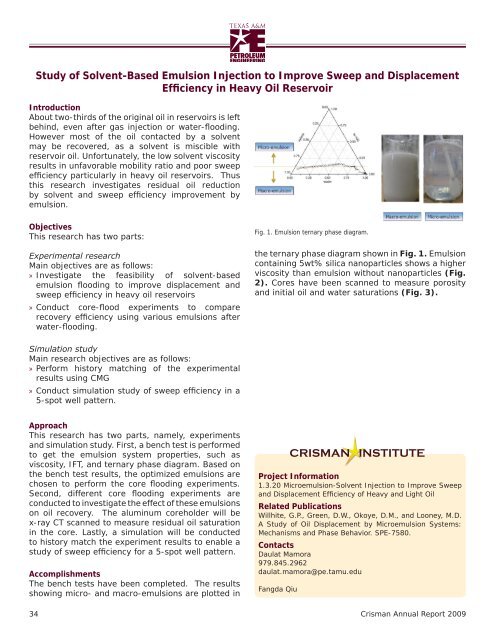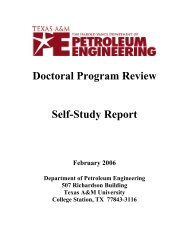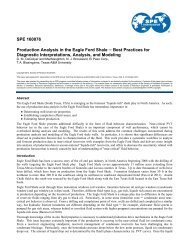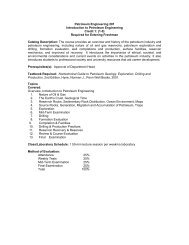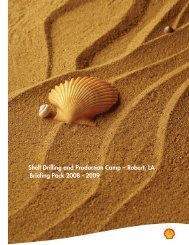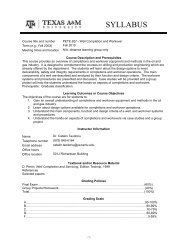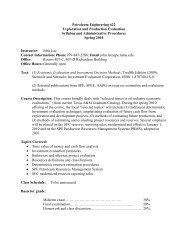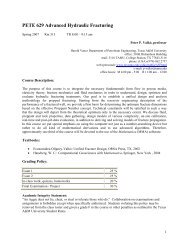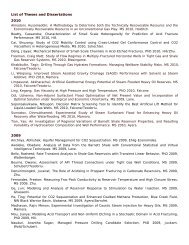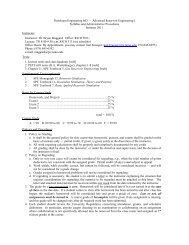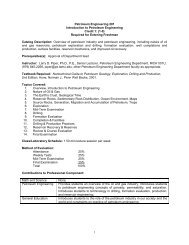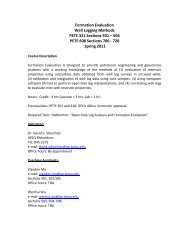Crisman Annual Report 2009 - Harold Vance Department of ...
Crisman Annual Report 2009 - Harold Vance Department of ...
Crisman Annual Report 2009 - Harold Vance Department of ...
Create successful ePaper yourself
Turn your PDF publications into a flip-book with our unique Google optimized e-Paper software.
Study <strong>of</strong> Solvent-Based Emulsion Injection to Improve Sweep and Displacement<br />
Efficiency in Heavy Oil Reservoir<br />
Introduction<br />
About two-thirds <strong>of</strong> the original oil in reservoirs is left<br />
behind, even after gas injection or water-flooding.<br />
However most <strong>of</strong> the oil contacted by a solvent<br />
may be recovered, as a solvent is miscible with<br />
reservoir oil. Unfortunately, the low solvent viscosity<br />
results in unfavorable mobility ratio and poor sweep<br />
efficiency particularly in heavy oil reservoirs. Thus<br />
this research investigates residual oil reduction<br />
by solvent and sweep efficiency improvement by<br />
emulsion.<br />
Objectives<br />
This research has two parts:<br />
Experimental research<br />
Main objectives are as follows:<br />
» Investigate the feasibility <strong>of</strong> solvent-based<br />
emulsion flooding to improve displacement and<br />
sweep efficiency in heavy oil reservoirs<br />
» Conduct core-flood experiments to compare<br />
recovery efficiency using various emulsions after<br />
water-flooding.<br />
Fig. 1. Emulsion ternary phase diagram.<br />
the ternary phase diagram shown in Fig. 1. Emulsion<br />
containing 5wt% silica nanoparticles shows a higher<br />
viscosity than emulsion without nanoparticles (Fig.<br />
2). Cores have been scanned to measure porosity<br />
and initial oil and water saturations (Fig. 3).<br />
Simulation study<br />
Main research objectives are as follows:<br />
» Perform history matching <strong>of</strong> the experimental<br />
results using CMG<br />
» Conduct simulation study <strong>of</strong> sweep efficiency in a<br />
5-spot well pattern.<br />
Approach<br />
This research has two parts, namely, experiments<br />
and simulation study. First, a bench test is performed<br />
to get the emulsion system properties, such as<br />
viscosity, IFT, and ternary phase diagram. Based on<br />
the bench test results, the optimized emulsions are<br />
chosen to perform the core flooding experiments.<br />
Second, different core flooding experiments are<br />
conducted to investigate the effect <strong>of</strong> these emulsions<br />
on oil recovery. The aluminum coreholder will be<br />
x-ray CT scanned to measure residual oil saturation<br />
in the core. Lastly, a simulation will be conducted<br />
to history match the experiment results to enable a<br />
study <strong>of</strong> sweep efficiency for a 5-spot well pattern.<br />
Accomplishments<br />
The bench tests have been completed. The results<br />
showing micro- and macro-emulsions are plotted in<br />
34<br />
Project Information<br />
1.3.20 Microemulsion-Solvent Injection to Improve Sweep<br />
and Displacement Efficiency <strong>of</strong> Heavy and Light Oil<br />
Related Publications<br />
Willhite, G.P., Green, D.W., Okoye, D.M., and Looney, M.D.<br />
A Study <strong>of</strong> Oil Displacement by Microemulsion Systems:<br />
Mechanisms and Phase Behavior. SPE-7580.<br />
Contacts<br />
Daulat Mamora<br />
979.845.2962<br />
daulat.mamora@pe.tamu.edu<br />
Fangda Qiu<br />
CRISMAN INSTITUTE<br />
<strong>Crisman</strong> <strong>Annual</strong> <strong>Report</strong> <strong>2009</strong>


